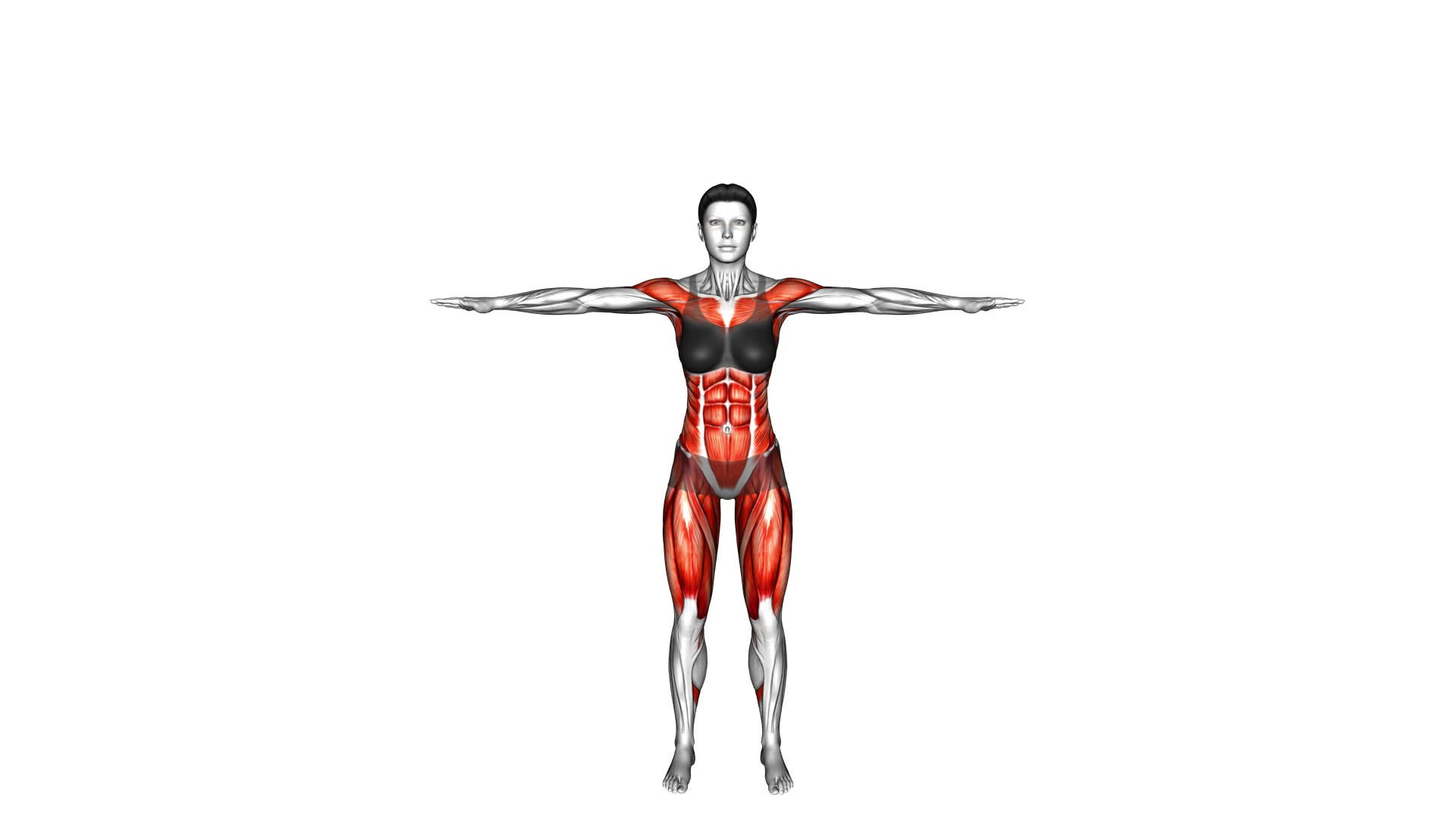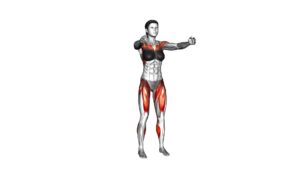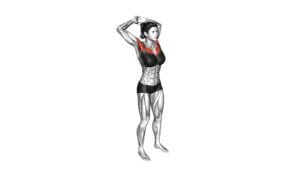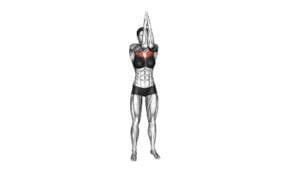Leg Raise Above Head and Under Knee Clap (female) – Video Exercise Guide & Tips

Get ready to tone, strengthen, and challenge your core with the leg raise above head and under knee clap exercise. In this video exercise guide, you'll learn the proper technique and form for this challenging move.
Watch This Exercise Video
Whether you're a beginner or an advanced fitness enthusiast, this exercise can be modified to suit your fitness level. Avoid common mistakes and maximize the effectiveness of this exercise with helpful tips and tricks.
Let's dive in and start sculpting those abs!
Key Takeaways
- Strengthens abdominal muscles
- Targets rectus abdominis and obliques
- Improves core strength, stability, and posture
- Works hip flexors
Benefits of the Leg Raise Above Head and Under Knee Clap
One benefit of the Leg Raise Above Head and Under Knee Clap is that it helps strengthen your abdominal muscles. This exercise targets your core, specifically the rectus abdominis and the obliques. By lifting your legs above your head and clapping under your knees, you engage these muscles to stabilize your body and maintain control throughout the movement. This can lead to improved core strength, stability, and posture.
In addition to the abdominal muscles, the Leg Raise Above Head and Under Knee Clap also works your hip flexors, which are responsible for lifting your legs. This exercise is a compound movement that engages multiple muscle groups, making it an efficient and effective way to strengthen your lower body.
To further target different muscle groups, you can modify the Leg Raise Above Head and Under Knee Clap. For example, by adding ankle weights, you can increase the resistance and challenge your muscles even more. Additionally, you can perform variations of this exercise on a decline bench or with a stability ball to engage different muscle fibers.
Now that you understand the benefits and variations of the Leg Raise Above Head and Under Knee Clap, let's move on to the equipment needed for this exercise.
Equipment Needed for the Exercise
What equipment do you need for the Leg Raise Above Head and Under Knee Clap exercise? To perform this exercise, you won't need any fancy or expensive equipment. Here are the three essential items you'll need:
- Exercise Mat: A comfortable and supportive exercise mat is crucial for this exercise. It provides cushioning for your back and prevents any discomfort or injury while performing the leg raise above head and under knee clap.
- Stability Ball: A stability ball is an optional but highly beneficial piece of equipment for this exercise. It adds an extra challenge and engages your core muscles even more. If you have access to a stability ball, place it between your feet before starting the exercise.
- Dumbbells: Adding dumbbells to this exercise can increase the intensity and help you build strength in your upper body. Choose dumbbells that challenge you but still allow you to maintain proper form throughout the movement.
Proper Technique and Form for the Leg Raise Above Head and Under Knee Clap
To properly execute the Leg Raise Above Head and Under Knee Clap exercise, continue by maintaining a strong core and engaging your upper body muscles. Begin by lying flat on your back with your arms extended above your head and your legs fully extended. Keep your legs straight and slowly raise them up towards the ceiling, lifting your hips off the ground. As you raise your legs, simultaneously bring your arms forward and clap your hands under your knees. Be sure to keep your core engaged throughout the movement to maximize the effectiveness of the exercise.
One common mistake to avoid is using momentum to lift your legs and hips. This can take away from the focus on your core and upper body muscles. Instead, focus on using your abdominal muscles to initiate the movement and maintain control throughout.
To modify this exercise, you can bend your knees slightly and perform the leg raise and knee clap with bent legs. This reduces the difficulty and allows you to build strength before progressing to the full exercise.
For those looking to progress, you can add ankle weights or hold a dumbbell between your feet to increase the resistance. This challenges your muscles even further and helps promote muscle growth and strength development.
Now that you have learned the proper technique and form for the Leg Raise Above Head and Under Knee Clap exercise, let's move on to discussing modifications and progressions for all fitness levels.
Modifications and Progressions for All Fitness Levels
As you progress in your fitness journey, you can modify and advance the Leg Raise Above Head and Under Knee Clap exercise to suit your current fitness level. Whether you're a beginner or looking for advanced progressions, there are options available to challenge yourself and continue improving.
Here are three modifications for beginners:
- Bent knee leg raise: If performing the exercise with straight legs is too challenging, you can start by bending your knees slightly. This modification reduces the strain on your core muscles while still engaging them.
- Supportive surface: If you find it difficult to maintain stability, you can perform the leg raise exercise while lying on a mat or bench. This provides additional support and helps you focus on proper form and technique.
- Leg raise with knee clap: Instead of raising your legs above your head, you can modify the exercise by raising them towards your chest and clapping your hands underneath your knees. This modification reduces the range of motion while still targeting your core muscles.
For those looking for advanced progressions, consider the following:
- Straight leg raise with ankle weights: To increase the intensity of the exercise, you can add ankle weights. This challenges your core muscles and adds resistance to the movement.
- Hanging leg raise: If you have access to a pull-up bar or hanging straps, you can perform the leg raise exercise while hanging. This engages your upper body muscles and further challenges your core stability.
- Leg raise with toe touch: As a more advanced variation, you can extend your legs fully and reach for your toes at the top of the movement. This requires greater flexibility and core strength.
Remember to always listen to your body and progress at a pace that feels comfortable for you.
Common Mistakes to Avoid During the Exercise
To maximize the effectiveness of the Leg Raise Above Head and Under Knee Clap exercise, be sure to steer clear of common mistakes. Proper technique is key to getting the most out of this exercise and avoiding any potential injuries.
One common mistake to avoid is using momentum to lift your legs instead of engaging your core muscles. Remember to keep your core tight and use controlled movements throughout the exercise.
Another mistake to watch out for is lifting your legs too high above your head. While it may seem impressive to lift your legs as high as possible, going beyond a 90-degree angle can put unnecessary strain on your lower back. Instead, focus on lifting your legs just high enough to clap your hands under your knees.
It is also important to maintain proper form throughout the exercise. Avoid arching your back or letting your legs drop too low when lowering them. Keep your back flat on the ground and your legs straight as you raise and lower them. This will help target the intended muscles and prevent any strain on your back.
Tips for Maximizing the Effectiveness of the Leg Raise Above Head and Under Knee Clap
To maximize the effectiveness of the Leg Raise Above Head and Under Knee Clap exercise, ensure that you maintain proper form and engage your core muscles throughout the movement. Here are some tips to help you get the most out of this exercise:
- Focus on your breathing: Pay attention to your breath as you perform the leg raise above head and under knee clap. Inhale deeply as you raise your legs above your head, and exhale as you bring your legs back down. This will help you maintain control and stability throughout the exercise.
- Engage your core: The key to this exercise is engaging your core muscles. To do this, imagine pulling your belly button towards your spine and squeezing your abdominal muscles. This will help stabilize your body and prevent any unnecessary movement.
- Maintain proper form: As you lift your legs above your head and clap your knees, be sure to keep your lower back pressed into the ground. Avoid arching your back or lifting your hips off the ground. Focus on using your core muscles to lift and lower your legs, rather than relying on momentum.
Frequently Asked Questions
How Long Should I Hold the Leg Raise Above Head Position Before Clapping Under the Knee?
Is it better to do the leg raise above head and under knee clap exercise with a partner?
When performing the leg raise above head and under knee clap, it's recommended to hold the leg raise position for a few seconds before clapping under the knee. This allows for proper engagement of the abdominal muscles and helps to improve core strength.
And what're some variations of this exercise?
As for variations, you can try adding ankle weights or performing the exercise on a stability ball for an added challenge.
Can Men Also Perform the Leg Raise Above Head and Under Knee Clap Exercise?
Yes, men can also perform the leg raise above head and under knee clap exercise. This exercise isn't specific to women only.
It's a great way to strengthen your core and hip flexors. By raising your legs above your head and clapping under your knees, you engage your abdominal muscles and increase flexibility.
This exercise can help improve your overall stability and balance. So, give it a try and enjoy the benefits!
Is It Necessary to Warm up Before Performing the Leg Raise Above Head and Under Knee Clap?
It's important to warm up before performing any exercise, including the leg raise above head and under knee clap. Warming up helps increase blood flow, flexibility, and reduces the risk of injury.
Incorporating dynamic stretches in your warm-up routine can be beneficial as it prepares your muscles for movement.
If you're looking for alternatives to the leg raise above head and under knee clap, you can try exercises like leg raises, bicycle crunches, or flutter kicks.
Remember to listen to your body and choose exercises that work best for you.
Can the Leg Raise Above Head and Under Knee Clap Exercise Help Improve Flexibility?
Yes, the leg raise above head and under knee clap exercise can help improve flexibility.
By engaging your core muscles and stretching your legs, this exercise can enhance your range of motion and increase flexibility in your lower body.
The benefits of this exercise go beyond just flexibility. It also strengthens your abdominal muscles and improves overall body control.
Incorporating this exercise into your routine can bring numerous benefits to your fitness journey.
How Often Should I Include the Leg Raise Above Head and Under Knee Clap Exercise in My Workout Routine?
To get the most out of your workout routine, it's important to know how often to include the leg raise above head and under knee clap exercise. This exercise can be modified for beginners by starting with smaller leg raises and gradually increasing the range of motion.
Incorporating this exercise in a Pilates routine has many benefits, such as improving core strength and flexibility. Aim to include it in your routine at least 2-3 times a week for optimal results.
Conclusion
In conclusion, the leg raise above head and under knee clap is an effective exercise that targets the core and lower body muscles. With proper technique and form, this exercise can help improve strength, stability, and flexibility.
It can be modified to suit different fitness levels and should be performed with caution to avoid common mistakes. By following the tips provided, you can maximize the effectiveness of this exercise and achieve your fitness goals.

Author
Years ago, the spark of my life’s passion ignited in my mind the moment I stepped into the local gym for the first time. The inaugural bead of perspiration, the initial endeavor, the very first surge of endorphins, and a sense of pride that washed over me post-workout marked the beginning of my deep-seated interest in strength sports, fitness, and sports nutrition. This very curiosity blossomed rapidly into a profound fascination, propelling me to earn a Master’s degree in Physical Education from the Academy of Physical Education in Krakow, followed by a Sports Manager diploma from the Jagiellonian University. My journey of growth led me to gain more specialized qualifications, such as being a certified personal trainer with a focus on sports dietetics, a lifeguard, and an instructor for wellness and corrective gymnastics. Theoretical knowledge paired seamlessly with practical experience, reinforcing my belief that the transformation of individuals under my guidance was also a reflection of my personal growth. This belief holds true even today. Each day, I strive to push the boundaries and explore new realms. These realms gently elevate me to greater heights. The unique combination of passion for my field and the continuous quest for growth fuels my drive to break new ground.







